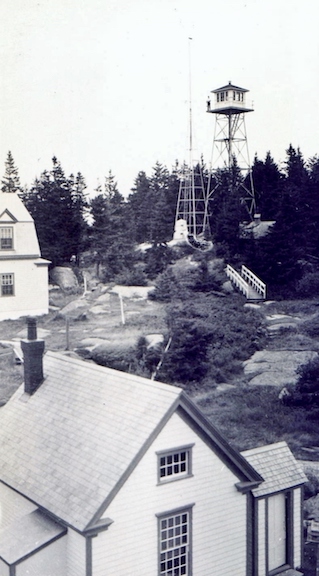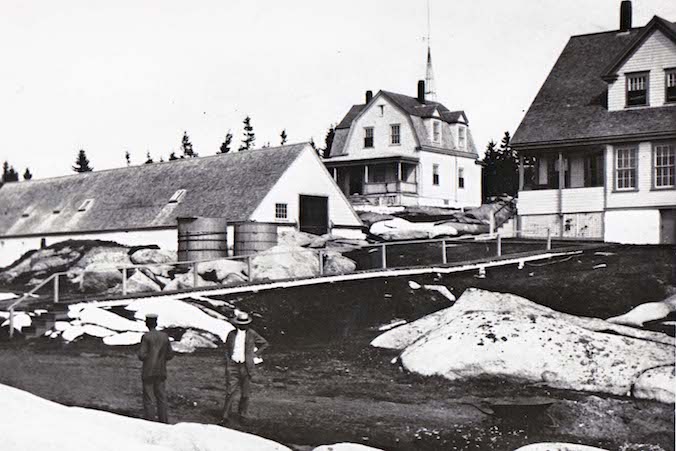You may have read the recent sidebar on the storm warning signal towers at Cape Elizabeth in the “From the Archives” column in the last issue of the 2016 Keeper’s Log. Society Member David Gamage provided the following article on the storm warning signal tower at Whitehead Island, Maine. He also provided a copy of the Instructions for Storm Warning Displaymen for the Society’s Archives.
The U.S. Weather Bureau provided a storm-warning display at Whitehead Island, Maine, following the installation of a telephone line from the mainland to the White Head Life-Saving Station in 1884. This phone enabled the communication necessary for timely display of the storm warnings.
Whitehead Island is located at the entrance to the Muscle Ridge Channel, a favored route in and out of the West Penobscot Bay for sailing vessels and steamships. The 1903 U. S. Coast Pilot listed seven other Maine storm signal sites at Eastport, West Quoddy Head, Machiasport, Bangor, Marshall Point Light, Boothbay Harbor, and Portland.

The Lighthouse Service approved a display flagpole near the Whitehead lighthouse at the eastern end of the island in 1887. In 1903 the Weather Bureau received permission to erect a storm warning display tower at the site of this display pole. The new iron skeletal tower was about 56 feet high and had a 24-foot telescoping metal pole extending upward from the tower apex. The top of this pole was 80 feet above the tower base and 155 feet above sea level. Attached to the pole near the apex was a lantern hoist sheave mount and at the bottom was the lantern-hoisting drum. Lanterns were suspended on a 5/16-inch cable. A metal building to store flags, lanterns and lantern fuel sat at the tower base.
A displayman employed by the Weather Bureau was responsible for hoisting and lowering the warning flags as needed and for maintaining the equipment.The displayman also maintained a lens lanterns which, when lit, produced a night signal. Instructions to hoist or to lower the storm warning flags and lanterns were received by telephone from Rockland; these instructions having been sent to Rockland by telegraph from the regional Weather Bureau office in Portland.
The displayman was required to submit a monthly record of wind signal displays to the Weather Bureau. This report included observations as to whether the actual wind direction and strength differed from the forecast as well as notations as to benefits derived by shipping interests, particularly for severe storms and hurricanes.
The first known displayman at Whitehead was Charles Shea, son of the life-saving station keeper. Shea also served as an alternate surfman at the life-saving station. Shea was the displayman until his death in September 1905. His widow Ida Shea replaced him.
Later the Whitehead principal light keeper became the displayman. Keeper Elmer Reed assumed the extra duties of hoisting the weather signals at Whitehead Light on July 27, 1917, for $120 a year. The Weather Bureau employed subsequent head keepers for this service until the early 1930s when the Weather Bureau discontinued the Whitehead Island storm signal display.

When mariners saw the Weather Bureau storm warning signals, they knew to wait out the storm in port or, when at sea, to seek a place of refuge. Unquestionably, these signals were of great benefit in terms of saving life and property.
Submitted by David Gamage, March 3, 2017
* * * *
U.S. Lighthouse Society News is produced by the U.S. Lighthouse Society to support lighthouse preservation, history, education and research. Please consider joining the U.S. Lighthouse Society if you are not already a member. If you have items of interest to the lighthouse community and its supporters, please email them to candace@uslhs.org.

Candace was the US Lighthouse Society historian from 2016 until she passed away in August 2018. For 30 years, her work involved lighthouse history. She worked with the National Park Service and the Council of American Maritime Museums. She was a noted author and was considered the most knowledgable person on lighthouse information at the National Archives. Books by Candace Clifford include: Women who Kept the Lights: a History of Thirty-eight Female Lighthouse Keepers , Mind the Light Katie, and Maine Lighthouses, Documentation of their Past.

